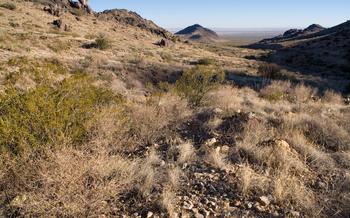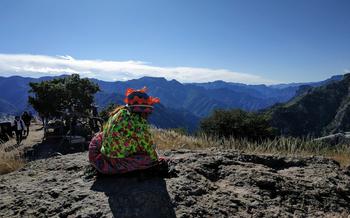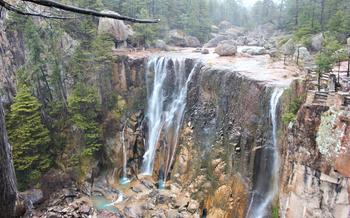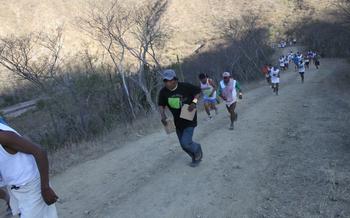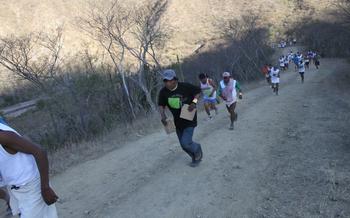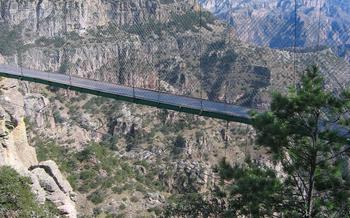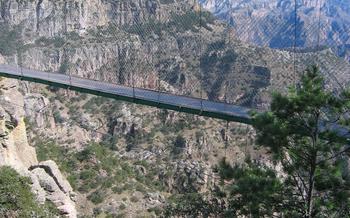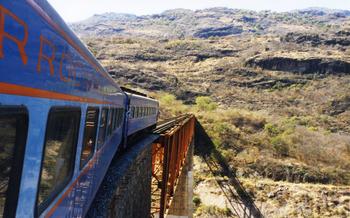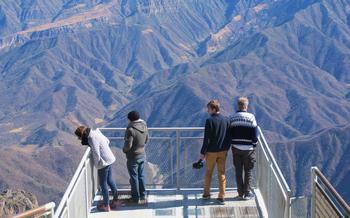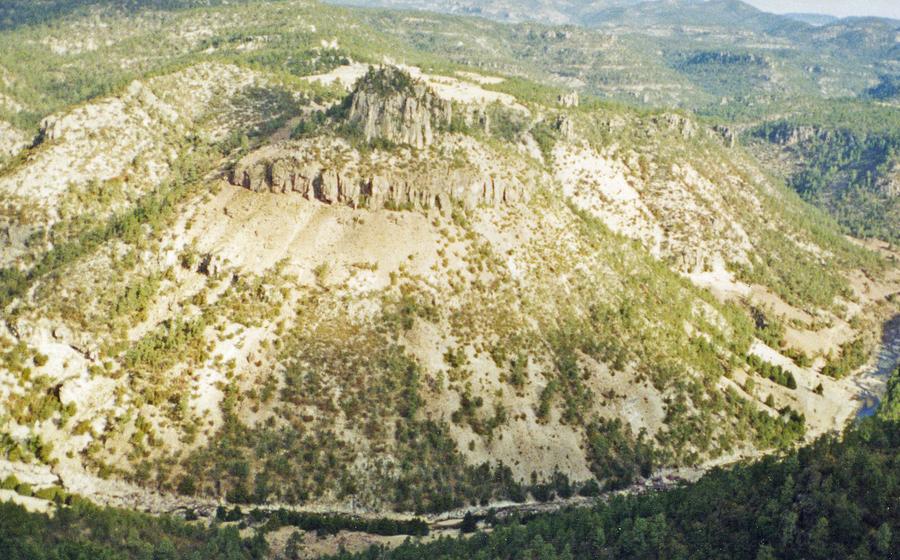
Nararachi Canyon
- Copper Canyon Overview
- Getting to the Copper Canyon
- Best Time to Visit
- Where to Stay
- Things to Do in Copper Canyon
- Nararachi Canyon Highlights
- Photography Tips
- Wildlife Spotting
- Local Culture and Cuisine
- Respecting the Environment
- Safety Considerations
- Budgeting for Your Trip
- Insider Tip: Hidden Gems
Copper Canyon Overview
In the heart of Mexico's Sierra Madre Occidental mountains, a vast and awe-inspiring natural wonder awaits – the Copper Canyon. Known as Barrancas del Cobre in Spanish, this breathtaking system of canyons dwarfs the Grand Canyon in the United States, stretching over an impressive 60,000 square kilometers. Its name derives from the green patina that coats the canyon walls, a result of oxidized copper deposits that have been weathered over millions of years. The Copper Canyon is a region of unparalleled beauty and diversity, encompassing towering cliffs, cascading waterfalls, lush forests, and vibrant indigenous cultures. Once home to the ancient Tarahumara people, who still inhabit the area today, the Copper Canyon offers a unique blend of adventure, history, and cultural immersion that is sure to leave an unforgettable mark on any traveler.
Getting to the Copper Canyon
There are several ways to reach the Copper Canyon, depending on your starting point and budget. The two main options are by plane and by train.
By Plane:
Flying is the fastest and most convenient way to get to the Copper Canyon. There are direct flights from major cities like Mexico City, Guadalajara, and Monterrey to the regional airports of Chihuahua, Los Mochis, and Culiacan. From these airports, you can take a bus or taxi to your desired destination within the canyon.
Advantages:
- Quick and efficient travel time.
- Convenient for those with limited time.
- Direct flights available from major cities.
Disadvantages:
- Can be more expensive than other options.
- Limited flight schedules to smaller towns.
- Requires additional transportation from the airport.
By Train:
The iconic "El Chepe" train is a popular way to experience the Copper Canyon. This scenic train journey runs between Chihuahua and Los Mochis, passing through some of the most breathtaking landscapes in the region. The trip takes around 15 hours and offers stunning views of canyons, rivers, and mountains.
Advantages:
- Unforgettable scenic experience.
- Comfortable and leisurely way to travel.
- Passes through remote and inaccessible areas.
Disadvantages:
- Longer travel time compared to flying.
- Limited train schedules and availability.
- Can be more expensive than other options.
Best Time to Visit
The Copper Canyon is a region with a varied climate depending on the altitude. It has two distinct seasons: dry and rainy.
The dry season runs from October to May and is characterized by warm and sunny days with cool nights. This is the ideal time to visit the canyon for outdoor activities, such as hiking, biking, and zip-lining. However, it is also the peak tourist season, so expect larger crowds and higher prices.
The rainy season lasts from June to September, and it is characterized by heavy rains, high humidity, and occasional thunderstorms. While the scenery is lush and green during this time, it can be challenging to enjoy outdoor activities. However, it is the low tourist season, so you'll find fewer crowds and lower prices.
The shoulder months of May-June and September-October offer a good balance of weather and crowds, making them a great time to visit the Copper Canyon.
Where to Stay
Copper Canyon offers a range of accommodation options to suit different budgets and preferences. For those seeking comfort and convenience, hotels in towns like Creel and El Fuerte provide modern amenities and easy access to local attractions. Hostels and guesthouses offer a more affordable option, often with shared dormitories and communal kitchens.
For a truly immersive experience, camping is a popular choice. Designated campsites are available in various locations throughout the canyon, allowing visitors to connect with nature and enjoy the tranquility of the surroundings. Prices for campsites vary depending on the facilities and amenities provided, but they generally offer a budget-friendly option for travelers.
Things to Do in Copper Canyon
Things to Do in Copper Canyon
The awe-inspiring landscapes and diverse ecosystems of Copper Canyon offer a plethora of activities for adventure seekers, nature enthusiasts, and culture buffs alike. Hiking trails of varying difficulty levels wind through the rugged terrain, leading to breathtaking viewpoints and hidden waterfalls. Mountain biking enthusiasts can embark on adrenaline-pumping rides along scenic trails, surrounded by towering cliffs and lush vegetation. For a unique perspective, soar through the canyons on a zip-line, gliding over the treetops and taking in the panoramic vistas.
Immerse yourself in the rich cultural heritage of the region by visiting indigenous communities, learning about their traditions, and experiencing their way of life. Participate in weaving workshops, traditional dances, and storytelling sessions to gain insights into their vibrant culture. A highlight for many visitors is the iconic train ride aboard "El Chepe," which traverses the canyons, offering unparalleled views and a truly memorable journey.
Nararachi Canyon Highlights
Introduction
Among the many stunning canyons in the Copper Canyon region, Nararachi Canyon stands out for its unique features and breathtaking landscapes. Here are some highlights that make this canyon a must-see destination:
Diverse Flora and Fauna:
-
Nararachi Canyon is home to a diverse array of plant and animal life, including rare and endemic species. From towering pine trees to vibrant wildflowers, the canyon's vegetation creates a rich and colorful tapestry.
-
The canyon is also a haven for wildlife, with sightings of majestic eagles, playful squirrels, and colorful hummingbirds. Visitors may even catch a glimpse of the endangered Mexican wolf, which roams the rugged terrain.
Dramatic Rock Formations:
-
The walls of Nararachi Canyon are adorned with impressive rock formations, carved by centuries of erosion. These towering cliffs, spires, and hoodoos create a mesmerizing backdrop for exploration.
-
The canyon's unique geology allows visitors to witness the power of nature and appreciate the intricate details of the rock formations.
Panoramic Viewpoints:
-
Nararachi Canyon offers several panoramic viewpoints that provide breathtaking vistas of the surrounding landscape. These viewpoints allow visitors to capture the sheer scale and beauty of the canyon from different perspectives.
-
Whether it's from the rim of the canyon or from a hidden viewpoint along the trail, the views from Nararachi are sure to leave a lasting impression.
Hidden Waterfalls:
-
While not as common as in other canyons in the region, Nararachi Canyon does have a few hidden waterfalls tucked away in its recesses. These waterfalls, fed by seasonal streams, create a serene and refreshing atmosphere.
-
Discovering these hidden gems is a rewarding experience that adds an element of surprise and wonder to the exploration of the canyon.
Cultural Significance:
-
Nararachi Canyon holds cultural significance for the indigenous communities that have inhabited the region for centuries. The canyon contains ancient ruins and artifacts, offering a glimpse into the rich history and traditions of the local people.
-
Visitors can learn about the cultural heritage of the region by interacting with local communities and exploring the historical sites within the canyon.
Photography Tips
Capturing the grandeur of Nararachi Canyon through photography requires careful consideration of lighting, composition, and camera settings.
Golden Hours are Key: The best time to shoot is during the golden hours, shortly after sunrise or before sunset. The warm, diffused light casts a magical glow on the canyon walls, creating stunning contrasts and depth.
Embrace Aperture and Shutter Speed: Experiment with your camera's aperture and shutter speed to achieve the desired effect. A wide aperture (low f-number) will blur the background, making your subject stand out. Conversely, a slow shutter speed will create a sense of motion, blurring moving elements like water.
Composition is King: Pay attention to composition to create visually appealing shots. Incorporate leading lines, such as winding trails or cascading waterfalls, to draw the viewer's eye into the image. Use the rule of thirds to position your subject off-center for a more dynamic composition.
Filters and Accessories: Consider using filters to enhance your photos. A polarizing filter can reduce glare and saturate colors, while a neutral density filter can help balance exposure in high-contrast scenes. A sturdy tripod will ensure sharp images, especially in low-light conditions.
Wildlife Spotting
The Copper Canyon is a haven for wildlife enthusiasts, with a diverse range of animals and birds calling this region their home. From majestic birds of prey soaring through the skies to elusive mammals roaming the rugged terrain, there's something for every nature lover to discover.
One of the most iconic species found here is the Golden Eagle, known for its impressive wingspan and hunting prowess. Keep an eye out for these majestic birds as they glide effortlessly above the canyons, scanning the terrain for their next meal.
Another highlight is the Tarahumara Frog, a unique amphibian found only in this region. With its vibrant colors and distinctive call, this frog is a symbol of the canyon's rich biodiversity.
For those interested in spotting mammals, the Copper Canyon is home to a variety of species, including bobcats, coyotes, and even the elusive jaguar. While these animals are more challenging to spot, their tracks and other signs of their presence can be found throughout the canyons.
To increase your chances of spotting wildlife, consider hiring a local guide who knows the best places to look and can help you identify different species. Remember to practice responsible wildlife viewing by maintaining a respectful distance and avoiding disturbing the animals in their natural habitat.
Local Culture and Cuisine
The Copper Canyon is home to several indigenous communities, including the Tarahumara (Rarámuri) people, who have lived in the region for centuries. These communities have their own unique cultures, traditions, and languages, and visitors to the canyon can learn about their way of life by visiting their villages and attending cultural events.
One of the best ways to experience the local culture is through food. The Tarahumara people have their own traditional dishes, such as pinole (a cornmeal porridge), tortillas, and stews made with local ingredients. Visitors can sample these dishes at local restaurants or by visiting indigenous communities.
The Copper Canyon region is also home to a number of cultural events and festivals throughout the year. These events offer a chance to see traditional dances, music, and crafts, and to learn more about the history and culture of the region.
Some of the most popular cultural events in the Copper Canyon include the Matachin dance, which is performed by men wearing colorful costumes and masks, and the Semana Santa (Holy Week) celebrations, which feature processions, reenactments, and other religious rituals.
Respecting the Environment
The Copper Canyon, including the Nararachi Canyon, is a pristine and fragile ecosystem that requires responsible tourism practices. Sustainable tourism is vital to preserve the natural beauty and cultural integrity of the region. Here are some ways you can contribute to eco-friendly travel:
-
Minimize waste: Avoid single-use plastics, such as water bottles and bags, and opt for reusable alternatives. Proper waste disposal is crucial, so carry a small trash bag to collect your waste and dispose of it responsibly.
-
Reduce pollution: Opt for walking or cycling as much as possible to reduce carbon emissions. If you must drive, carpool or rent a fuel-efficient vehicle. Be mindful of noise pollution and respect the tranquility of the natural surroundings.
-
Support local businesses: Choose accommodations, restaurants, and tour operators that are locally owned and operated. This not only supports the local economy but also ensures that tourism benefits the community directly.
-
Leave no trace: Respect the natural environment by leaving no trace of your presence. Do not disturb wildlife, damage plants, or leave any litter behind. Always practice responsible camping and hiking etiquette.
By embracing sustainable tourism practices, you can help preserve the Copper Canyon for future generations while enjoying its natural and cultural wonders responsibly.
Safety Considerations
While the Copper Canyon is generally safe for travelers, there are certain precautions you should take to ensure a smooth and enjoyable trip. Petty theft and scams can occur, so be wary of your belongings and avoid carrying large amounts of cash. It's advisable to make copies of important documents and leave the originals in a secure place.
Altitude sickness is a common issue in the region, especially if you're not acclimatized. Symptoms include headaches, nausea, and shortness of breath. To prevent this, ascend gradually, drink plenty of fluids, and avoid strenuous activities upon arrival. If symptoms persist, seek medical attention.
When hiking or exploring the canyons, always let someone know your itinerary and expected return time. Stick to designated trails, wear appropriate footwear, and carry sufficient water and snacks. Be aware of the weather conditions and be prepared for sudden changes.
Respect the local culture and traditions. Ask permission before photographing people or sacred sites, and avoid wearing revealing clothing. Learn a few basic Spanish phrases to communicate with the locals and show your appreciation for their culture.
Budgeting for Your Trip
Exploring the Copper Canyon and Nararachi Canyon can be an affordable adventure if you plan your budget wisely. Accommodation options range from basic hostels starting at $10 per night to mid-range hotels with amenities around $50-$100 per night. Food costs can be kept low by opting for local markets and restaurants, where you can savor traditional dishes for a few dollars.
Transportation within the region is relatively inexpensive, with bus fares between major towns ranging from $5 to $20. Guided tours and activities can vary in price, but you can expect to pay around $30-$50 for a day trip or a basic hiking tour.
Here are some tips for saving money without compromising on your experiences:
-
Cook your own meals: Save on dining expenses by purchasing groceries from local markets and preparing your own meals in shared kitchen facilities.
-
Utilize public transportation: While renting a car offers flexibility, it can be more expensive. Take advantage of the reliable and affordable bus system to get around the region.
-
Choose budget-friendly activities: There are plenty of free or low-cost activities to enjoy, such as hiking, swimming in natural pools, and visiting local villages.
-
Shop around: Don't hesitate to compare prices for tours and activities. Look for discounts and bundle packages to get the best value for your money.
-
Bargain and negotiate: Don't be afraid to haggle with vendors and tour operators. Bargaining is a common practice in Mexico, and you can often get a better deal if you ask.
Insider Tip: Hidden Gems
Beyond the popular attractions, the Copper Canyon region is home to hidden gems waiting to be discovered. Venture off the beaten path to find secluded viewpoints that offer breathtaking panoramas of the canyons. Explore lesser-known trails that lead to pristine waterfalls, ancient cave dwellings, and untouched natural beauty.
For an unforgettable experience, embark on a horseback riding adventure through the rugged terrain, allowing you to immerse yourself in the unspoiled wilderness. Discover hidden canyons and remote villages, where you can interact with the local indigenous communities and learn about their rich cultural traditions.
To truly embrace the spirit of adventure, consider camping under the stars in one of the many designated campsites. As darkness falls, the canyon transforms into a celestial wonderland, with millions of stars illuminating the night sky. It's an experience that will leave you feeling connected to nature and in awe of the universe's vastness.
